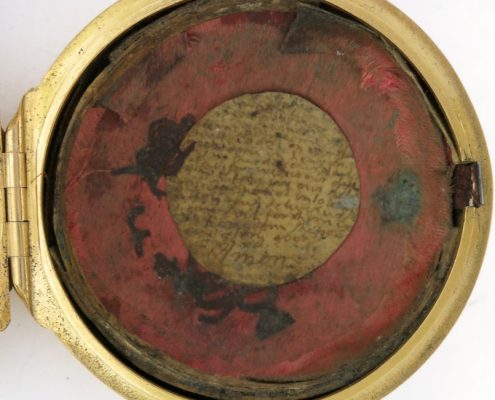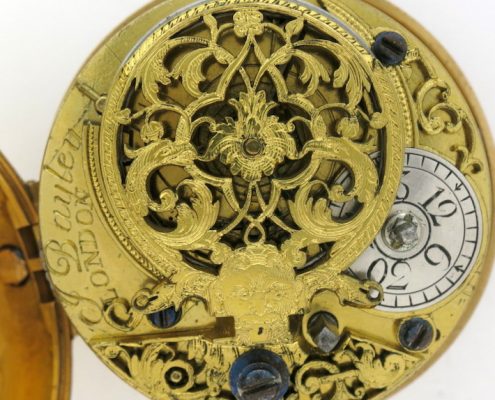Stock No. : 1307
J. Bayley
London, 1725
Gold pair cases
Verge movement
Sold
An early 18th century London verge with an interesting Scottish provenance.
MOVEMENT : Gilt verge movement, with engraved and pierced winged balance cock, silver regulator disk and blued screws. Signed ‘J. Bayley, LONDON’. Four square pillars.
All in good original condition, with very little wear, and running well. The only damage is to the gilt stop work bracket in front of the fusee, where a small piece from the left hand side is missing.
DIAL : White enamel dial, in fine condition with just a small chip at the opening catch at 6. Good. original 18th century steel beetle and poker hands.
This is probably a replacement dial as most watches of this period were made with gold or silver champleve dials. During the late 18th century many champleve dials were replaced with more up to date enamels.
INNER CASE : 22ct. gold, with worn London hallmarks, maker JB? (rubbed). The letter year is very worn, but appears to be ‘K’ for 1725.
All in very good condition, with just some light scratches to the band. The hinge is fine and the bezel closes correctly.
Good high dome bull’s eye crystal with no damage.
OUTER CASE : A 22ct. gold pair case, with no hallmarks but matching maker’s mark JB.
Engraved on the back with a coat of arms showing a tree beneath the word Revirescit
There are no dents or damage, though a little wear to the engraving.
The hinge and catch are fine though the catch button has worn through, showing the red wax infill. The bezel snaps shut nicely.
The gold cases weigh 44.5 gms (excluding movement and crystal).
The outer case holds some interesting watch papers :
A very small, handwritten, copy of the Lord’s Prayer.
Thomas Reid of Edinburgh, dated 1794 (very early for a paper).
J&W Howden of Edidburgh, dated 1821.
Provenance :
This watch is from the Forbes family of Pitslogo and Fettercairn (Fettercairn House, Kincardineshire).
The arms engraved on the outer case are those of Belsches of Tofts (this family also owned the Fettercairn estate, from 1783).
Also a Jacobite symbol. The oak was an ancient Stuart badge and an emblem of· the Stuart Restoration. Charles II hid in an oak during the English Civil War, and in 1660 he wore oak leaves as he returned from· exile in France to assume the throne. Frequently with the motto “Revirescit” (it revives, it grows green again, it shoots again) the oak is a symbol of restoration and regeneration.















